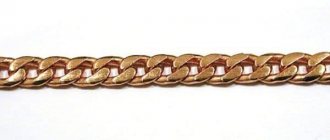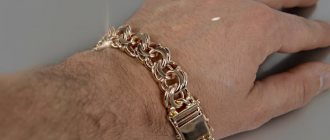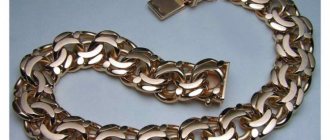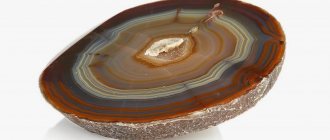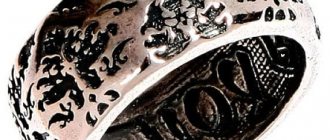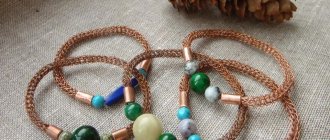Many products do not require expensive materials or decoration with jewelry - the technique itself makes them aesthetically pleasing and original. Professionals use a weave called “Fox Tail” (known as “Byzantine” or “Venetian” weave) when making jewelry from silver and gold. Such original works are popular primarily due to their unique design and method of connecting individual elements.
The fox tail is quite complex to execute, but the resulting result looks unusual and original. A chain using this technique does not require additional decorations in the form of pendants or pendants. Moreover, their use is not recommended, since any addition will distract attention from the pattern. In a certain sense, using any additional decorations along with the Fox's tail is considered a manifestation of bad taste.
This technique is most widely used for making chains. There are a great many options and modifications of this type of weaving, and jewelers never tire of inventing new ones.
A silver men's chain in this style usually looks stylish and original. Weaving a chain in the Fox tail style is also popular among women. Products of this type are traditionally considered the prerogative of mature ladies, but there are also suitable options for young girls.
The history of the discovery of such technology
The history of the technology is interesting. According to experts, it goes back to the distant Bronze Age. Some of the first samples were found at royal graves in the city of Ur, which is located in the Middle East. However, it was never possible to reliably find out where exactly the weaving itself came from. Some historians suggest that it appeared in Byzantium (this hypothesis gave one of its names).
Another part of the researchers is inclined to believe that the invention belongs to the masters of Ancient Greece and Rome.
This jewelry technology quickly gained popularity and spread widely throughout Europe, soon coming to Russia. Even now, a large number of jewelers from all over the world use Fox Tail to obtain various copies of ancient jewelry from ancient times, to make something new and unique, and also to decorate their original works. A large number of private craftsmen in Moscow make amazing products and jewelry based precisely on this technique, trying to make something new and original.
History of appearance
The manufacture of products made using this “link-to-link” joining method began in the Bronze Age. The first examples of chains were found during excavations of royal graves in the city of Ur in what is now the Middle East.
However, it is impossible to reliably determine where the foxtail weave comes from. Many attribute its appearance to the merits of Byzantine jewelers, which is fundamentally incorrect, but quite understandable: in the 7th century, this technology was improved by Greek and Roman craftsmen. They created methods for connecting several rows of links into one strip. As a result, fox tail weaving has become widespread in European countries and Russia.
Today, craftsmen resort to using it to produce copies of antique jewelry, create independent products, and also as an additional element in original work.
Characteristic features and weaving methods
This technique has distinctive characteristics. It must be said right away that the Fox tail and “Byzantine” weaving types are not exactly the same thing. The first is a variation of the second. In general, the “Byzantine” is characterized by a tight connection of several rings in one row (chain mail weaving), however, only for the “fox tail” it is necessary that all the rings be directed in one direction.
If the “Byzantine” weaving can look heavy and massive due to the protruding rings, then the “fox tail” is distinguished by its subtlety and grace.
The peculiarity of chains of this type is the dense arrangement of links, in which there are practically no gaps. This is what makes the products look massive and dense. However, despite the tightly spaced links, this weaving is quite flexible.
The appearance of the finished chain depends not only on the location of the links, but also on their shape. For foxtails, square links are more often used, which can be easily laid in one direction without protruding or standing out.
Weaving features
“Fox tail” is often called Byzantine, but this is not entirely true. In fact, these types are somewhat different. Byzantine weaving is a type of “Bismarck”, and it is based on the connection of elements of different sizes, directed randomly, into one link, which is why the decorations have a rather massive appearance. In the “fox tail”, all the rings are laid in one direction, which makes it more elegant.
However, today very few people know about this difference, as a result of which even the masters themselves sometimes combine both of these varieties into one, calling “fox tail” weaving Byzantine.
Types of weaving
A chain or bracelet using this technology is made in different ways: they differ mainly in the shape and elements.
1. The assembled Fox Tail is made from parallel rows of links, which are twisted in several directions during the manufacturing process. Each of these rows is assembled by a craftsman from six thin rings and connected manually using wire. This gives the decoration new shapes and patterns that can be varied. These types of products are distinguished by a fairly high quality indicator, however, their price is high. 2. Circle. Characterized by the highest strength among other types of weaving, Fox tail. With this option, the internal ligaments are distributed completely evenly by the craftsmen. Thanks to this feature, all rounded spirals cannot be torn or deformed in any way; the decoration is strong and reliable. 3. Semicircle. This type of weaving is similar to the previous version, however, the radius at which the elements are bent is somewhat smaller. This affects the strength: it is not as high as that of a circle, but a semicircle can also be considered a fairly reliable weave. In addition, it has features that attract jewelry connoisseurs - its original and unusual appearance. 4. Square. It consists of a large number of rings with the addition of wires and special links for tying. Thanks to this very extensive combination, craftsmen create massive chains and bracelets. This option is ideal for those who prefer reliability along with a wide variety of weaves in jewelry.
Experts also note that the Fox Tail itself, in any of the weaving options, has high density and strength. It is almost impossible to break the chain. If desired, you can hang a talisman or pendant on it (however, this should be done with caution, since most pendants will interrupt the chain pattern and distract attention from it). Strength will allow you to withstand pendants of any weight. In this case, you need to choose an outfit that will focus only on the product. For example, ladies can wear a black dress with a high collar or, conversely, expose their cleavage as much as possible. It is preferable for men to unbutton the first buttons of their shirt, thereby allowing access to view the decoration.
Remember, the pendant or pendant should match the chain or bracelet as closely as possible. It is considered bad manners if they are of the wrong size or are made in a different style.
Kinds
Thanks to the processing of links, craftsmen achieve various effects that add originality to the product when creating jewelry using the “fox tail” technique. Weaving a chain or bracelet has several possible types, differing in the shape of the elements:
- The assembled “fox tail” consists of spirals twisted in different directions. Each link is assembled from six thin rings, connected by hand with wire, which allows you to create a unique pattern. The cost of such a product will be extremely high.
- The circle is a variety famous for its durability. Thanks to the uniform distribution of internal ligaments, the rounded spirals of the links cannot be torn apart.
- Semicircular weaving has a smaller bend radius of the element.
- The latter type has a square cross-section and is composed of rings, wires and link links, making it ideal for creating chunky chains and bracelets.
Moreover, such a chain (weaving “fox tail” in any of the modifications listed above) has good density, which allows you to put additional pendants on it. Their number is not limited, but they must have a mass less than the total weight of the product.
The advantages of such weaving
Fox tail weaving has a number of advantages that elevate it over other types. The main advantage is that you can come up with different shapes, combinations and vary it as the master’s soul desires! In addition, the amount of materials that can be used for work is very large. Brass, silver or even gold - the product in any of its forms will look stylish and original.
Chains and bracelets made of precious alloys and metals are popular not only in Russia, but throughout the world. They are used not only by girls, but also by quite a large number of men. Despite the high price of handmade products, the popularity of fox tail weaving shows no signs of waning.
Manufacturing technique
“Fox tail” is woven only by hand: there are no machines capable of making a chain using this technique yet. Weaving requires great skill from the jeweler and is considered one of the most difficult. To accomplish this, links of different shapes are connected in series:
- square;
- oval;
- round.
The thickness of the links determines the width of the future chain or bracelet.
The process of weaving a “Fox Tail” is labor-intensive and painstaking. The master uses special curved thin-nose pliers without notches, carefully connecting the elements together. The work takes a lot of time and requires maximum concentration on the process.
Both hollow and solid metal wire can be used to make a chain. In the first case, you will get a “blown” chain, in the second - a cast one.
Who is recommended to wear
Jewelry workshops most often receive orders for such weaving from representatives of the stronger half.
A men's silver Bismarck or Figaro chain, made using this technique, not only completes the look externally, but also adds self-confidence. After all, jewelry is not just a part of the wardrobe, but also, to some extent, a talisman. Women are recommended to purchase chains and bracelets made using the Fox Tail technique from thinner and more elegant elements.
Masters can offer the following options for original works:
• variable interlacing of silver and gold parts; • gold items made of different shades of metal: lemon, white, red; • distribution of precious and semi-precious stones on the outer part of the jewelry or inside the links.
As you can see, everything depends only on the imagination and skill of the performer and the customer. Remember, original works are always valuable and can be an excellent gift and a profitable investment in the future.
Varieties
Depending on the shape of the links, the following varieties of “Fox Tail” are distinguished:
- Round. The elements look like rounded spirals, which ensures even load distribution.
- Semicircular. A similar variety, but with a smaller bend radius of the spiral.
- Square. Consists of square links and link rings. It looks rougher and is often found in men's accessories.
- Decorative. A combination of the classic “Fox Tail” and other weaving techniques. Forms a chain reminiscent of the original necklace.
Any of the varieties is characterized by a high density of weaving. It can be used as an independent decoration or in combination with a pendant.
Why are copyrighted works so expensive?
People who are not familiar with all the features of jewelry are often worried about the question: why is the price of products made using the Fox Tail technique so high? The answer is simple:
• painstaking work takes a lot of time to assemble all the elements into one pattern; • parts can only be connected manually; • you should first prepare a huge number of parts from which the decoration will be assembled.
In addition, even a short chain 50 cm long requires at least 30 grams of precious metal.
Advantages and disadvantages
“Fox tail” is valued for the following qualities:
- strength - it is almost impossible to accidentally break the chain;
- flexibility - weaving from small links can be bent at different angles without fear of creases;
- aesthetics - the decoration looks unusual and bright both with and without a pendant.
The disadvantage of weaving is that it turns out to be quite heavy. The average weight of a chain 50 cm long is 25 grams. Because of this, as well as exclusively handmade work, the cost of the product will be quite high.
“Fox tail” is difficult to clean: dust and dirt quickly gets clogged into the winding structure of the weave. Home cleaning only removes surface stains. After purchasing, you will have to pay additional costs for ultrasonic cleaning 1-2 times a year.
A chain or bracelet made using this technique should be removed at night and during physical activity. It is unlikely that it will be possible to tear a cast product, but it is quite possible to catch it on a protruding edge and deform it. In addition, the volumetric chain will interfere with complete relaxation.
